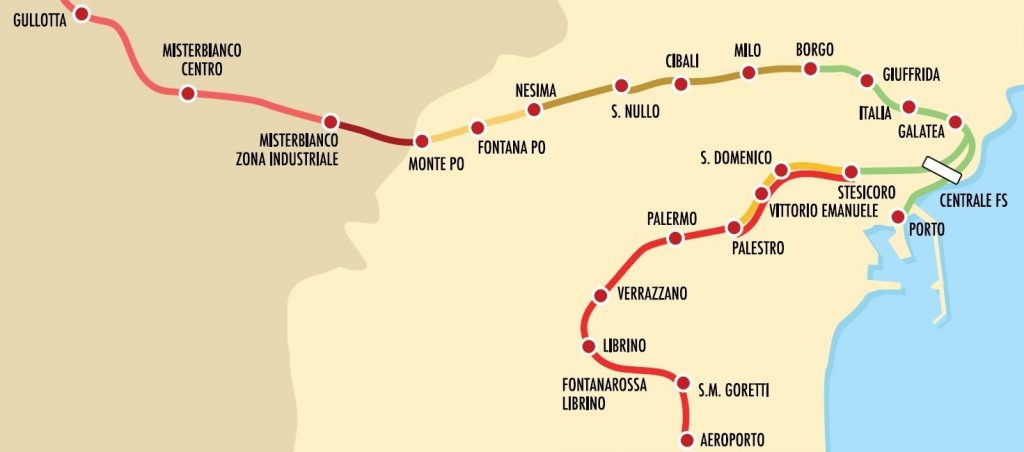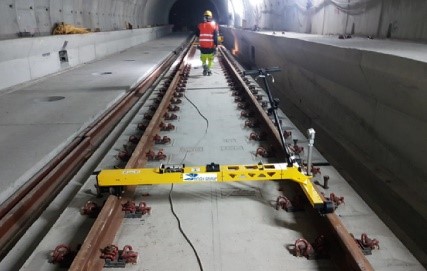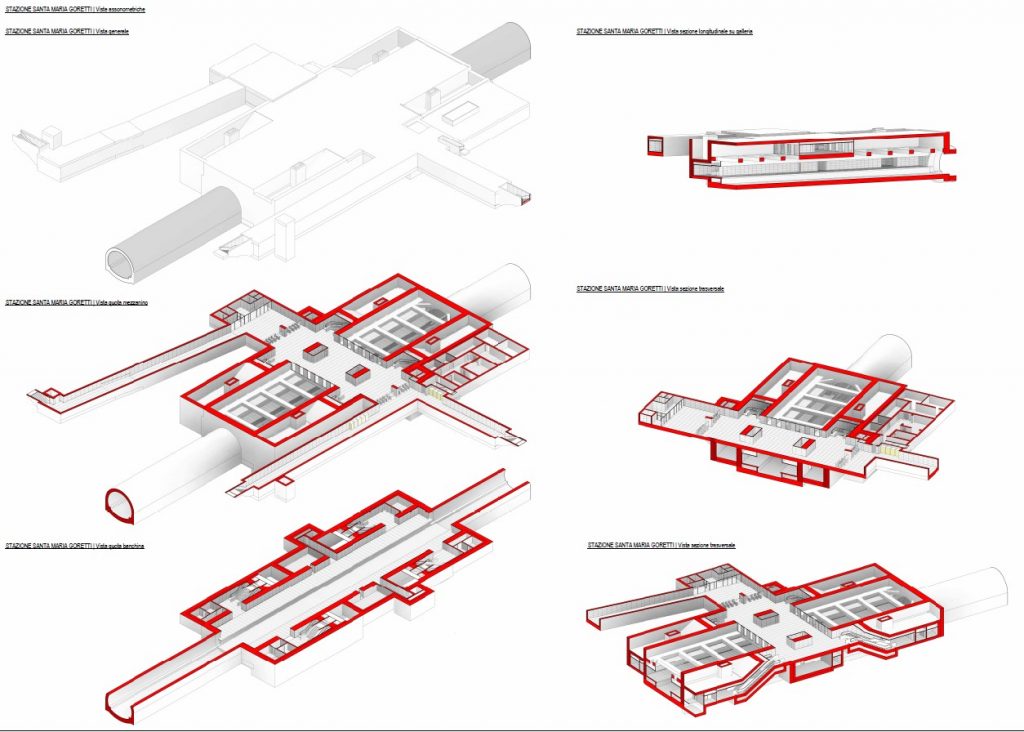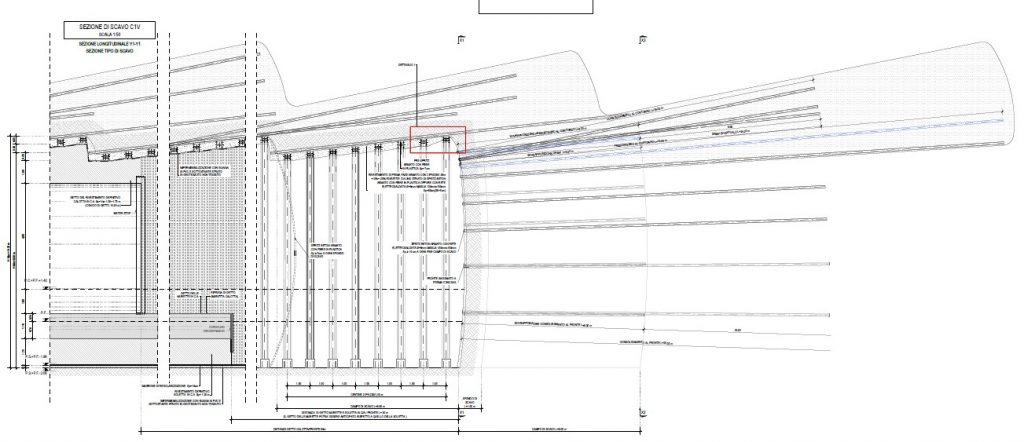AUTORE: Giuseppe Rapuano
TUTOR: Giovanni Franchi
MASTER: Master in “PROJECT AND SAFETY MANAGER IN CONSTRUCTION WORKS” a.a 2021/2022
Il presente lavoro di tesi riguarda la correlazione tra la teoria base del project management nel campo della costruzione delle infrastrutture ed un caso reale come la costruzione di un tratto di metropolitana di Catania a cui lo scrivente ha partecipato attivamente sia durante la fase di gara per l’appalto integrato e sia durante lo sviluppo della progettazione esecutiva, quale il “Prolungamento della rete ferroviaria nella tratta metropoli – tana di Catania dalla Stazione Centrale F.S. all’Aeroporto – Tratta Stesicoro – Aeroporto – Lotto di Completamento”.Il presente lavoro ha riguardato il rapporto tra le aspettative, legate a molteplici obbiettivi, dello sviluppo della commessa e la realtà. È stato svolto un parallelo dedicato con le annesse considerazioni, talvolta anche espresse dai “principali addetti ai lavori”.
Il Progetto complessivo della tratta Stesicoro-Aeroporto consiste nell’ampliamento dell’attuale metropolitana della Ferrovia Circumetnea, in parte in esercizio ed in parte in corso di realizzazione, nell’ambito del centro urbano di Catania. Prevede la realizzazione di una tratta funzionale di linea ferroviaria in galleria con caratteristiche di metropolitana, avente la lunghezza di 6.8 km, avente lo scopo di collegare i quartieri periferici della parte sud-ovest della città con l’aeroporto “Fontanarossa” di Catania.
Il completamento della tratta Stesicoro-Aeroporto (il cui primo lotto è già in corso di costruzione nell’ambito di altro appalto) contempla la costruzione della galleria di linea dalla progressiva 4+104,10 sino alla stazione Aeroporto, il completamento delle n.3 stazioni del primo lotto e la costruzione delle restanti n.5 stazioni, nonché la realizzazione di tutti gli impianti di linea e di stazione.
La procedura di gara prevedeva, oltre alla produzione della documentazione amministrativa, la presentazione della squadra sia dal punto di vista impresa e sia dal punto di vista progettisti che soddisfaceva i criteri minimi richiesti dalla stazione appaltante in linea con il Codice degli Appalti, e la redazione della offerta tecnica ed economica premiale rispetto a quanto contemplato nel disciplinare di gara. Allo scopo il consorzio Medil, capitanato da F.B., ha pianificato la gestione dell’offerta mediante l’individuazione dei responsabili di offerta. In particolare: Responsabile documentazione amministrativa; Responsabile documentazione tecnica; Responsabile offerta economica; Responsabile del coordinamento delle imprese.
Le procedure di gara, in generale, si configurano come un meccanismo di progressiva selezione dei concorrenti, che si conclude con l’individuazione dell’aggiudicatario. La prima selezione avviene al momento della partecipazione, sulla base dei requisiti soggettivi richiesti: solo gli operatori economici in possesso dei requisiti generali, di idoneità professionale, economico-finanziari e tecnico-professionali, questi ultimi definiti dalla stazione appaltante in relazione alle caratteristiche dell’affidamento, possono partecipare alla procedura e presentare offerta. La seconda selezione avviene invece mediante la valutazione delle offerte prodotte dai concorrenti ammessi e l’individuazione dell’aggiudicatario (del concorrente cioè che ha presentato la migliore offerta). Quest’ultimo vaglio avviene sulla base di un “criterio di aggiudicazione”, definito dalla stazione appaltante prima dell’avvio della procedura e indicato nella documentazione di gara. Tale meccanismo di selezione consente di individuare l’ “offerta economicamente più vantaggiosa”, l’offerta cioè che propone alla stazione appaltante le migliori condizioni e/o soluzioni, sulla base dei seguenti metodi: miglior rapporto qualità/prezzo; minor prezzo; minor costo; migliore offerta tecnica, sulla base di un prezzo o di un costo fissi.
Il RTP progettazione, in fase di gara, ha svolto un importante value engineering della commessa in cui sono stati analizzati le principali criticità connesse alla realizzazione dell’opera a partire dalla disamina dei documenti di progetto.
Complessivamente è stato stimato, in fase di gara, un deficit di ricavi per una somma pari ad almeno 15 ML di euro di cui si è tenuto conto nell’ambito della determinazione del ribasso.
Lo sviluppo della progettazione esecutiva ha visto impegnate sia la compagine di imprese, che poi dovranno eseguire i lavori, e sia la compagine di progettisti. La suddivisione delle competenze è stata operata riflettendo ciò che era stato già eseguito in fase di gara. In questo modo sono state ottimizzate sia le risorse e sia gli expertises coinvolti. Il periodo della progettazione si è protratto ben oltre i limiti temporali a disposizione rispetto al contratto. Le difficoltà incontrate dalla compagine di progettisti sono legate a:
- Livello di dettaglio del progetto definitivo alquanto carente
- Indagini geognostiche insufficienti;
- Interferenze geometriche non valutate nell’ambito del progetto definitivo;
- Tecniche dei consolidamenti non atte al contesto geologico emerso;
- Carenze economiche nel computo metrico;
- Problematiche legate alla subsidenza durante gli scavi;
- Maggiori costi per la mitigazione dei cedimenti indotti alle infrastrutture ed ai fabbricati;
- Mutate esigenze rispetto alla stazione aeroporto;
- Necessità di modificare l’asse del tracciato;
- Necessità di modificare il sistema costruttivo e le uscite delle stazioni;
- Modifiche delle uscite equilibratrici;
- Adeguamento al DM 2015 del sistema antincendio;
- Problematiche legate alla gestione dei rifiuti;
- Maggiori costi per la risoluzione di problemi legati alla sicurezza dei lavoratori;
- Maggiori costi per il ritrovamento di una sacca di gas in prossimità della stazione di Verrazzano;
- Problematica legata alla variazione dei prezzi relativa al caro materiali;
È stata condotta una campagna geognostica integrativa, finalizzata a verificare il modello geologico-geotecnico del progetto definitivo del lotto di completamento, per un totale di circa 1337 ml di carotaggio su un tracciato della lunghezza di circa 4.5 km, che corrispondono ad una frequenza media di un punto di indagine ogni 100 m di tracciato.
Il piano di indagine integrativo è stato finalizzato alla ricostruzione di un attendibile modello geotecnico di progetto per lo scavo in sotterraneo. Il progetto esecutivo ha altresì previsto l’introduzione delle opportune soluzioni progettuali conseguenti all’esito delle verifiche “a liquefazione” ed al rinvenimento di gas infiammabili a quota scavo.
Gli interventi provvisionali necessari per l’esecuzione degli scavi sono stati riprogettati in funzione dei nuovi parametri geotecnici degli ammassi. In particolare si è ricorso ai consolidamenti eseguiti con la tecnica del Jet Grouting, allo scopo di assicurare l’effetto “arco” occorrente per garantire la stabilità del cavo, laddove le caratteristiche geotecniche dei terreni, associate alle ridotte coperture disponibili, non consentivano il raggiungimento delle condizioni di sicurezza con la tecnica prevista dal progetto definitivo (iniezioni di miscele cementizie). Le ridotte coperture hanno peraltro imposto di realizzare gli stessi consolidamenti dal piano di campagna.
La metodologia costruttiva delle stazioni è stata modificata, ricorrendo alla realizzazione di strutture “a pozzo”, al fine di rendere l’inserimento delle opere compatibile con il contesto in cui si collocano. Ne deriva pertanto una diversa organizzazione delle fasi lavorative, che contemplano attività da svolgere in superficie e l’inevitabile interazione con l’ambiente circostante, densamente urbanizzato.
L’intero lavoro, in conformità a quanto indicato nella vigente Normativa, è stato condotto secondo la – Caratterizzazione geologica del sito, la Programmazione delle indagini geotecniche, la Caratterizzazione fisico-meccanica dei terreni e delle rocce presenti nel volume significativo e definizione dei modelli geotecnici di sottosuolo.
A seguito di tali aspetti è stato possibile sviluppare le soluzioni progettuali definendo la caratterizzazione e la modellazione geotecnica. Per modello geotecnico del sottosuolo si intende uno schema rappresentativo del volume di terreno interessato dall’esecuzione dell’opera entro in quale vengono definite delle tratte a comportamento meccanico omogeneo, assegnando parametri caratteristici di resistenza e deformabilità. Nel modello geotecnico di sottosuolo va definito altresì il regime delle pressioni interstiziali, il quale condiziona le scelte progettuali relative agli interventi necessari alla realizzazione delle varie parti d’opera.
La campagna di rilievi e prove geognostiche, condotta in fase di progettazione esecutiva, ha evidenziato l’interferenza con alcune infrastrutture preesistenti, quali la linea ferroviaria in località Zia Lisa, la rampa dello svincolo San Giorgio dell’asse attrezzato e la galleria provvisionale, utilizzata per il lancio della fresa dall’Appaltatore esecutore dei lavori del primo lotto della tratta in argomento. Pertanto, il progetto esecutivo è stato corredato dei singoli progetti di risoluzione delle suddette interferenze, da sottoporre all’approvazione dei competenti Enti Gestori.
Il Budget della commessa è il documento previsionale che confronta la stima dei costi con i ricavi definiti in genere dalle condizioni contrattuali. È un documento amministrativo utile a qualsiasi tipo di impresa e per qualunque settore di attività. In esso l’azienda formalizza tutte le operazioni di gestione futura che ha intenzione di attuare per il conseguimento di un profitto. È, analogamente, una previsione accurata dei piani finanziari che costituiscono guida fondamentale della direzione del cantiere e del project manager. È utile per la redazione della offerta economica correlata ad una precisa gestione del cantiere.
È stato elaborato un Budget, con riferimento ai costi, che oltre a valorizzare le quantità di progetto, comprende:
– le maggiori quantità rispetto al computo contrattuale (residue);
– le migliorie proposte in fase di gara (residue);
– la stima delle possibili ottimizzazioni da applicare in corso d’opera.
I costi unitari sono dedotti dalle offerte pervenute, da valori di mercato noti, dalle analisi fatte dal gruppo di lavoro.
I ricavi sono stati oggetto di stima e dipendono da dinamiche anche indipendenti dalla gestione dell’appalto. La “marginalità minima” si potrà raggiungere solo appellando al diritto della rinegoziazione del Contratto in quanto l’importo delle variazioni ha superato abbondantemente il 20% dell’importo contrattuale. Si tratta quindi di discostarsi dall’attuale meccanismo di indennizzo per il caro materiali, vincolato temporalmente a decreti emergenziali e quantitativamente agli aggiornamenti del prezziario RFI, ottenendo il riequilibrio del contratto alla luce delle mutate condizioni.
Occorrerà pertanto un lavoro particolarmente gravoso di indagine di mercato, esteso a circa 700 voci di contratto, dimostrando, con opportune analisi prezzo, la non congruità degli ultimi aggiornamenti al prezziario RFI.
Ad oggi, in considerazione di tutto quanto esposto, la commessa è caratterizzata da un margine positivo del +4.81% contro un utile di impresa teorico atteso del 10%.
CONSIDERAZIONI FINALI
Per offrire un prodotto che coniughi il miglior rapporto qualità/prezzo da parte della stazione appaltante, così come previsto dal codice dei contratti pubblici, è fondamentale che il livello di progettazione, almeno per i progetti definitivi, sia stato già assoggettato a pareri con le relative risoluzioni, e solo successivamente, prevedere la pubblicazione della gara di affidamento lavori e progettazione (trattandosi di appalto integrato), lasciando la libertà ai concorrenti di procedere alle ottimizzazioni di natura ingegneristica ed esecutiva dell’opera e prevedere miglioramenti estetici e funzionali senza modificare quanto già accuratamente progettato ed approvato.
La commessa può considerarsi remunerativa se verranno mantenute/accettate da parte della S.A le condizioni economiche paventate da Medil quali il riconoscimento del maggior importo dovuto alla progettazione esecutiva pari a 100 ML e la revisione dei prezzi.
L’ipotesi di indirizzo verso lo stralcio funzionale, per un repentino inizio della fase di cantierizzazione che comprende l’esecuzione della stazione di partenza e di fine lotto oltre alla messa in esercizio della linea, è la più concreta e realizzabile per poi valutare il più idoneo percorso di rifinanziamento a breve termine dell’opera che consentirebbe il successivo completamento delle opere connesse alla messa in esercizio delle stazioni intermedie.
L’appalto e la sua esecuzione comporteranno in capo all’appaltatore una ingente profusione di mezzi, uomini, competenze per poter realizzare il lavoro in ossequio a quanto prescritto dalla normativa vigente, dal protocollo di legalità e dal contratto sottoscritto tra le parti.
A partire dal 1° gennaio 2015, con la legge di stabilità, è entrato in vigore lo “split payment”, con l’inserimento del nuovo art. 17-ter nel D.P.R. n. 633/1972. Con questo meccanismo l’esecutore dell’opera fattura al committente pubblico con l’applicazione dell’iva ma incassa dallo stesso solo l’imponibile, in quanto è stesso l’ente pubblico che versa l’iva direttamente allo Stato. Solo imprese salde da un punto di vista finanziario, nonché economico possono affrontare e portare a termine lavori così grandi.
Medil su questa commessa si è assunto l’onere di una sfida importante. Per certi versi unica. Per tutto quanto esposto in termini di criticità se Medil supera questo impegno contrattuale assunto automaticamente ne esce collaudata rispetto ad ogni tipo di impegno e difficoltà sia dal punto di vista amministrativo, sia dal punto di vista finanziario e sia dal punto di vista lavorativo. Sarà una battaglia durissima ma visti i personaggi coinvolti e gli impegni profusi Medil ne uscirà vincente.
FOR INTERNATIONAL STUDENTS:
This thesis deals with the correlation between the basic theory of the project management in the field of infrastructure construction and a real case study, i.e. the construction of a section of the Catania subway which actively involved the writer both in the competitive bidding process for the integrated contract, both in the development of the executive design of “Extension of the railway network in the metropolitan section of Catania from the F.S. Central Station to the Airport – Stesicoro Section – Airport – Completion Lot”.
This work concerns the relationship between the expectations based on multiple objectives of the commission development and the reality. Comparisons were carried out highlighting the related considerations, sometimes expressed by the “major insiders” as well.
The project of the Stesicoro-Airport section consists of the expansion of the current Circumetnea railway underground, partly in operation and partly under construction, within the urban centre of Catania. The construction of a functional section of railway line in a tunnel is planned, with the characteristics of a subway, having a length of 6.8 km, with the aim of connecting the peripheral districts of the south-west part of the city to the airport of Catania “Fontanarossa”.
The completion of the Stesicoro-Airport section (the first lot is already under construction as part of another contract) involves the construction of the line tunnel from progressive 4+104.10 up to the Airport station, the completion of 3 stations of the first lot and the construction of the remaining 5 stations, as well as the construction of the line-side equipment and the station systems.
The competitive bidding process required the production of the administrative documentation, the presentation of the team concerning both the company and the designers with the minimum criteria required by the contracting authority according to the Procurement Code, and the drafting of the technical and economic proposal with respect to what is reported in the tender specifications. For this purpose, the Medil consortium, headed by F.B., planned the management of the proposal through the identification of the following managers: the manager for the administrative documentation, the manager for the technical documentation, the manager for economic offer manager, the manager for coordination of the enterprises.
In general, the bidding processes are a mechanism of progressive selection of the competitors which ends with the individuation of the contractor. The first selection occurs on the basis of the subjective requisites: only the economic operators that have the general, professional, economic-financial and technical-professional suitability requirements, the latter defined by the contracting authority according to the characteristics of the assignment, can participate in the procedure. The second selection occurs through the evaluation of the proposals produced by the admitted bidders and the identification of the contractor (that is, the bidder who presented the best proposal). This last screening is based on an “awarding criterion”, defined by the contracting authority before the start of the procedure and indicated in the documentation of the bidding process. This mechanism of selection allows to identify the “most economically advantageous proposal”, i.e., the one which proposes the best conditions and/or solutions to the contracting authority, based on the following methods: best quality/price ratio; lower price; lower cost; best technical offer, on the basis of a fixed price or cost.
During the tender phase, the design temporary working group, starting from the examination of the project documents, carried out an important value engineering of the commission analysing the main issues connected to the construction of the work.
Overall, a revenue deficit was estimated for a sum of at least 15 million of euros which was considered to determine the bidding discount.
The development of the executive design has involved both the group of companies, which will have to carry out the works, and the team of designers. The division of the responsibilities was made following the indications provided in the tender phase in order to optimise both the resources and the expertise involved. The design period extended beyond the time limits available in the contract. The difficulties encountered by the design team are related to:
- Lack of the detail of the final project;
- Insufficient geognostic investigations;
- Geometric interferences not evaluated in the final project;
- Consolidation techniques not suitable for the geological context;
- Economic deficiencies in the bill of quantities;
- Issues related to subsidence during excavations;
- Higher costs for the mitigation of subsidence induced in infrastructures and buildings;
- Changed needs of the airport station;
- Need to change the axis of the line;
- Need to modify the building system and the station exits;
- Changes of the balancing outputs;
- Adjustment of the fire prevention system to the Ministerial Degree of 2015;
- Waste management issues;
- Higher costs for the resolution of the problems due to workers’ safety;
- Higher costs for the discovery of a gas pocket near the Verrazzano station;
- Variation on the prices due to the extra costs of the materials;
To verify the geological-geotechnical model of the final project of the completion lot, a supplementary geognostic campaign was carried out averaging of one survey point for every 100 m of the layout (1337 ml of coring for the layout about 4.5 km long.)
The supplementary investigation plan was aimed at reconstructing a reliable geotechnical model for the underground excavation. The executive project also provided for the introduction of the appropriate design solutions following the outcome of the liquefaction checks and the discovery of flammable gases at excavation height.
The provisional interventions necessary for the excavations were redesigned according to the new geotechnical parameters. In particular, consolidations were carried out with the Jet Grouting technique in order to ensure the “arch” effect necessary to guarantee the stability of the cavity. This technique was chosen as alternative of that envisaged by the final project (injections of cement mixtures) which did not allow to reach the safety conditions due to the geotechnical characteristics of the land, associated with the limited available coverage. The reduced coverage required to perform the consolidations from the countryside level.
The construction methodology of the stations has been modified, employing the construction of “well” structures in order to make the works compatible with the environmental context. The result is a different organization of the work phases which contemplate activities to be carried out on the surface and the inevitable interaction with the surrounding environment densely urbanized.
The entire work was carried out in compliance with the provisions of current regulations according to the Geological characterization of the site, the planning of the geotechnical investigations, the physical-mechanical characterization of the soils and rocks present in the significant volume and the definition of the geotechnical models of the subsoil.
Following these aspects, the design solutions were developed by defining the geotechnical characterization and modelling. The geotechnical model of the subsoil means a representative scheme of the volume of land affected by the execution of the work. In this volume, sections with homogeneous mechanical behavior are defined assigning the characteristic parameters of strength and stiffness. The interstitial pressure regime has to be defined in the subsoil geotechnical model as well because it affects the design choices for the realization of the various parts of the work.
The campaign of surveys and geognostic tests, performed in the executive planning phase, highlighted the interference with some pre-existing infrastructures, such as the railway line in the Zia Lisa locality, the ramp of the San Giorgio junction of the equipped axis and the provisional tunnel, used for the launch of the milling machine by the Contractor executing the works of the first lot. To solve these interferences the executive project was accompanied by individual resolution projects that need to submitted for approval by the Management Bodies.
The Budget of the project is the forecast document that compares the estimation of the cost with the revenues generally defined by the contractual conditions. This administrative document is useful to any type of company and for any sector of activity and reports all the future management operations that the company intends to implement for the achievement of a profit. It is an accurate forecast of the financial plans which are an essential guidance for the site management and the project manager. It is useful for drafting the economic proposal related to an accurate management of the site.
In reference to the costs, the Budget has been developed including both the quantities of the project and:
- the greater quantities compared to the contractual calculation (residual);
- the improvements proposed in the tender stage (residual);
- the estimation of the possible optimizations to be applied during the construction.
The unit costs were obtained from the offers received, from the market values, from the analyses carried out by the working group.
The estimated revenues depend on the dynamics that can be also independent from the management of the contract. The “minimum margin” can only be achieved by appealing to the renegotiation right of the Contract as the amount of the changes has far exceeded the 20% of the contractual amount. Therefore, the question is to depart from the current compensation mechanism for the price increase of the materials, temporally due to emergency decrees and to updates of the price list of the Italian Railway Network (RFI), thus obtaining the rebalancing of the contract as consequence of the changed conditions.
Therefore, a particularly onerous market survey will be required, extended to approximately 700 contract items, demonstrating the incongruity of the latest updates of the price list of RFI by appropriate price analyses.
Based on the foregoing, the commission is characterized by a positive margin of +4.81% against an expected theoretical profit of 10%.
FINAL REMARKS
To offer a product that combines the best quality/price ratio by the contracting station, as required by the public procurement code, it is essential that the design level, at least for the final projects, has already been subject to opinions with the relative resolutions. After this step, the publication of the competitive bidding process for the integrated contract (assignment of works and design) is permitted, allowing the competitors to proceed with the engineering and executive optimizations of the work for the aesthetic and functional improvements without modifying the original approved design.
The commission can be considered remunerative if the economic conditions feared by Medil are maintained/accepted by the contracting authority, such as the recognition of the higher amount due to the executive design (100 million of euros) and the revision of the prices.
The most concrete and feasible hypothesis for a sudden start of the construction phase is that of addressing the functional excerpt which includes the execution of the start-station and the end-station of the lot as well as the commissioning of the line. After that, the most suitable short-term refinancing path for the work can be evaluated, allowing for the subsequent completion of the works connected with the commissioning of the intermediate stations.
The contract and its execution will involve the contractor in a huge profusion of means, men, skills to be able to carry out the work in compliance with the provisions of current code, the protocol of legality and the contract signed by the parties.
From the 1st of January 2015, with the stability law, the “split payment” came into effect, with the insertion of the new art. 17-ter in the Presidential Decree no. 633/1972. By this way, the executor of the work invoices the contracting authority with the application of VAT collecting only the taxable amount from the same, as the public body pays the VAT directly to the State. Only financially and economically solid companies can face and complete such large jobs.
Medil has taken up an important challenge by contracting this commission. Regarding all the issues previously discussed, if Medil exceeds this commission it will automatically come out tested on any type of commitment and difficulty about the administrative, financial and working aspects. It will be a very tough battle, but thanks to the characters involved and the efforts made Medil will come out victorious.






